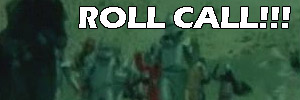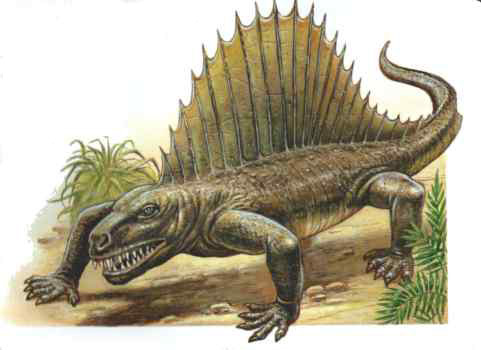Ecosystem Remodelling Among Vertebrates During The Permian-Triassic Extinction
ScienceDaily (Nov. 9, 2004) — The biggest mass extinction of all time happened 251 million years ago, at the Permian-Triassic boundary. Virtually all of life was wiped out, but the pattern of how life was killed off on land has been mysterious until now. A team from Bristol University and Saratov University, Russia, have now laid the evidence bare.
The Bristol and Russian researchers have documented the event in Russia after looking at 675 specimens of amphibians and reptiles from 289 areas spanning 13 successive geological time zones in the South Urals basin. The study will be reported in Nature Thursday, November 4.
The mass extinction at the Permian-Triassic boundary is accepted as the most profound loss of life on record. Records indicate a loss of 50 per cent of animal groups or more, in both sea and on land, with a loss of 80 to 96 per cent of species. Local and regional-scale studies of marine specimen confirm the loss, but the terrestrial record has been harder to analyse in such close detail.
There was a profound loss of animal groups, and simplification of ecosystems, with the loss of small fish eaters and insect eaters, medium and large herbivores and large carnivores. Plant life also changed, from high rates of turnover through the Late Permian period to greater stability at low diversity through the Early Triassic period. Even after 15 million years of ecosystem rebuilding, some groups were still absent—small fish eaters, small insect eaters, large herbivores and top carnivores.
The end-Permian mass extinction is now thought to have been caused by gigantic volcanic eruptions, which triggered a runaway greenhouse effect and nearly put an end to life on earth.
Mike Benton, Professor of Vertebrate Palaeontology and Head of the Department of Earth Sciences at Bristol University, said: “At the end of the Permian there was a high turnover in animal families on land however these were largely destroyed by the Permian-Triassic extinction. However, after that the animal groups recovered slowly and diversity gradually increased.â€
Ecosystem remodelling among vertebrates at the Permian–Triassic boundary in Russia, M J Benton, Department of Earth Sciences, University of Bristol, Bristol and V P Tverdokhlebov and M V Surkov, Geological Institute of Saratov State University, Russia. Nature, 4 November 2004.
Adapted from materials provided by University Of Bristol.
Whale River
Dead whale found in river, scientists puzzled
Young beluga was hundreds of miles from oceanFriday, June 16, 2006; Posted: 1:39 p.m. EDT (17:39 GMT)
ANCHORAGE, Alaska (AP) — Scientists are mystified by the carcass of a young beluga whale found in a river in central Alaska, nearly 1,000 miles from its natural ocean habitat.
The first guess is the 8-foot-long whale, which often feed on fish in estuaries and the mouths of rivers, swam away from the ocean in search of food.
“What are the alternatives?” asked Link Olson, a curator at the University of Alaska Museum of the North.
It was highly unlikely that someone was perpetrating a hoax along a remote section of river with a whale carcass, he said.
“If you were ever close to a dead marine mammal, even for a few hours, you would know why no one in their right mind would do that.”
Canoeists found the whale June 9 on the Tanana River about 40 miles southwest of Fairbanks.
Sylvia Brunner, a marine mammals researcher at the museum in Fairbanks, identified the decomposing carcass and oversaw its recovery on Wednesday.
The “bloated, black thing on the beach” was about 12 feet from the river’s edge, she said.
It could have died in the river last fall and frozen during the winter, Brunner said. On the other hand, the whale could have entered the river this spring seeking fish heading for the ocean.
“When you get a carcass like that, there are a lot of unanswered questions,” she said.
The carcass was taken to the museum, where it will be “cleaned and prepared as a full skull and skeleton and we will preserve tissue samples,” Olson said.
Belugas are toothed whales and belong to the same group as sperm whales, killer whales, dolphins, and porpoises, according to the Alaska Department of Fish and Game.
He's got those shrimpy eyes…

Weird Shrimp Has Astounding Vision
ScienceDaily (May 15, 2008) — A Swiss marine biologist and an Australian quantum physicist have found that a species of shrimp from the Great Barrier Reef, Australia, can see a world invisible to all other animals.
Dr Sonja Kleinlogel and Professor Andrew White have shown that mantis shrimp not only have the ability to see colours from the ultraviolet through to the infrared, but have optimal polarisation vision — a first for any animal and a capability that humanity has only achieved in the last decade using fast computer technology.
“The mantis shrimp is a delightfully weird beastie,” said Professor White, of the University of Queensland. “They’re multi-coloured, their genus and species names mean ‘mouth-feet’ and ‘genital-fingers’; they can move each eye independently, they see the world in 11 or 12 primary colours as opposed to our humble three, and now we find that this species can see a world invisible to the rest of us.”
Dr Kleinlogel, is based at the Max Planck Institute for Biophysics in Frankfurt, and collected the shrimp from the reef. She notes that, “…scuba divers know them as ‘thumb-splitters’, they’ve got wickedly strong claws and are very aggressive!”
Prehistoric crocodiles

Scientists Unveil Prehistoric “Sea Warrior” Crocodile
A fossil of a new prehistoric crocodile species “Guarinisuchus munizi” is seen during a press conference at National Museum of the Rio de Janeiro Federal University in Rio de Janeiro, Wednesday, March 26, 2008. Brazilian scientists say they have found a new prehistoric crocodile species that inhabited the Earth’s oceans some 62 million years ago.
(Ricardo Moraes/AP Photo)Pointy-nosed crocodiles may have joined sharks as the dominant predators in the world’s oceans some 62 million years ago, according to Brazilian scientists who on Wednesday unveiled one of the most complete skeletons found yet of the prehistoric animals.
Scientists called it a new species, “Guarinisuchus munizi,” and said it sheds new light on the evolutionary history of modern crocodiles.
The fossil includes a skull, jaw bone and vertebrae, making it one of the most complete examples of marine crocodylomorphs collected so far in South America, said Alexander Kellner of the National Museum of the Federal University of Rio de Janeiro. He and other scientists unveiled fossils and a model of the 10-foot-long crocodile at the museum.
“It’s a very rare find and it gives rise to several new theories,” said Kellner, who co-authored an article on the find that was published Tuesday in Proceedings of The Royal Society B, a London-based peer-reviewed journal.
Guarinisuchus appears to be closely related to marine crocodylomorphs found in Africa, which supports the hypothesis that the group originated in Africa and migrated to South America before spreading into the waters off the North American coast, Kellner said.
The find also suggests that marine crocodylomorphs replaced marine lizards during the early Paleocene era, about 65 million years ago — the same time marine lizards became extinct. They believe it’s a new species based on anatomical differences in the skull that are unique to this creature.
Philip Currie, a paleontology professor at the University of Alberta, Canada who was not involved with the discovery, said it was an important find.
“There are a lot of unknowns with this group in terms of evolution. Clearly the discovery of a specimen as nice as this one will help sort things out,” Currie said in telephone interview.
The bones were found in the northeastern state of Pernambuco. Scientists named the species “Guarinisuchus” after the Tupi Indian word “Guarani,” which means warrior and “munizi,” in honor of Brazilian paleontologist Deraldo da Costa Barros Muniz, who has discovered many dinosaur fossils off Brazil’s northeastern coast. Muniz didn’t participate in this find.
Scientists have discovered a wealth of crocodile ancestors around Brazil in recent years.
In January, they announced the discovery of an 80 million-year-old land-bound reptile described as a possible link between prehistoric and modern-day crocodiles.
Two years ago, paleontologists from the Federal University of Rio de Janeiro announced the discovery of a 70-million-year-old crocodile fossil that they called Uberabasuchus Terrificus, or “Terrible Crocodile of Uberaba.”
This “Terrible Crocodile of Uberaba” sounds interesting, so let’s dig up that story:

‘Terrible crocodile of Uberaba’ unveiled
Fossil offers look at Earth’s ecosystem of 70 million years ago
Thursday, February 17, 2005 Posted: 2109 GMT (0509 HKT)
RIO DE JANEIRO, Brazil (AP) — The discovery of a nearly intact fossil of a prehistoric crocodile is
teaching scientists what the world was like before the continents were separated by oceans, a Brazilian paleontologist said.
A reproduction of the previously unknown creature — dubbed Uberabasuchus terrificus, or the terrible crocodile of Uberaba, was unveiled Wednesday at the Federal University of Rio de Janeiro.
Uberabasuchus lived 70 million years ago and was smaller than today’s crocodiles — only about three meters (10 feet) long and weighing about 300 kilograms (650 pounds), said paleontologist Ismar de Souza Carvalho.
“It’s important because the fossil was extremely well preserved, with 85 percent of its skeleton practically complete and intact,” he said.
Carvalho said Uberabasuchus lived on land — it was named because the fossil was found near Uberaba, an inland city in southeastern Brazil. It probably carried its body high off the ground on sturdy legs and was a strong and voracious hunter, he said.
“We’re learning about a new species of crocodile, the ecosystem of 70 million years ago, and the evolution of the land crocodile on the ancient continent of Gondwana,” Carvalho said.
Scientists believe the continents then were joined in a huge land mass, which some call Gondwana. Fossils similar to Uberabasuchus have been found in Africa and in Antarctica, which possibly were linked to South America.
Despite some similarities with modern-day crocodiles, Uberabasuchus became extinct when the other great dinosaurs died out, and it has no relation to today’s crocodiles, Carvalho said.
Brazil has drawn international attention for its recent discoveries of prehistoric creatures.
In December, scientists unveiled a replica of Unaysaurus tolentinoi, an ancestor of the huge Brontosaurus, that lived 230 million years ago in what is now southern Brazil. Experts said it was more closely related to fossils found in Germany than to dinosaurs from neighboring Argentina.
Zootaxa, a scientific journal published in New Zealand, said Unaysaurus “differs from all other dinosaurs.”
Carvalho predicted there was more to come.
“Important new discoveries are practically certain,” he said.
Sonny Chiba to return as Nanairo Kamen (Seven-Color Mask) in new film
Variety is reporting Sonny Chiba will reprise his role as Seven-Color Mask in an upcoming movie:

Action icon Sonny Chiba is prepping a pic based on the pioneering Tokusatsu TV series “Nanairo Kamen” (Seven-Color Mask) via his shingle, Kyoto-based Thousand Leaves Hollywood.
The series, which gave Chiba his first starring role, ran on the predecessor to the TV Asahi network from 1959-60.
Chiba will reprise the title role, fulfilling a promise he made to series creator Kohan Kawauchi, who died last month at age 88.
Godzilla Island – Story Arc 12
Godzilla Island – Story Arc 12

1997![]()

Directed by Shun Mizutani

You wanted a giant story arc, and here it is! 22 episodes long! At three minutes each, that’s over an hour of story! And it has a huge cast, major transitions to the character line-up in the series, and even TWO Jet Jaguars! Jet Jaguar is cool. Zaguresu’s latest evil plan is her most complex, and the stakes for her succeeding are higher than ever, because Giant Emperor has lost patience with her failures. So Godzilla Island must look out, as March of Godzilla Island continues!!!!

If you are new here or got lost looking for photos of Hong Kong celebrities or lesbians, we’re going through the entire series of Godzilla Island. Head on over to Story Arc 1 and get caught up. There, caught up? Good, get to reading episodes 104-125 right now! Because time’s a wasting!

|
Different monster feature in each episode, so we’ll keep track of them in each story arc. The complete Godzilla Island Daikaiju List is located here. We’ll also list any new monster match-ups that weren’t in any film but now exist thanks to this series, such as Kamacuras fighting Megalon or something. The R2 Japanese DVD release is unsubtitled, so most of what is going on will be educated guesses thanks to our limited Japanese speaking ability. But here at TarsTarkas.NET we don’t need no stinking subtitles!

Podcast: Play in new window | Download




